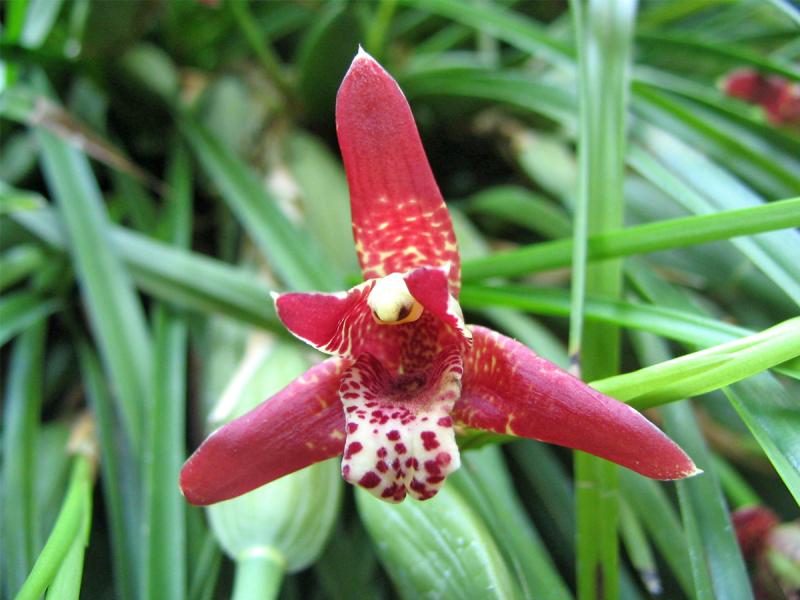When Portuguese sailors first saw huge nuts on palm trees, they thought they looked like skulls, so they used the Portuguese “coco” meaning “head,” and coconuts entered the language. These are strange plants indeed. During World War II, coconut juice or coconut water was used as a substitute for plasma in IV drips.
Burning coconut husks creates coconut char, which is so good at filtering poisons, it is a key ingredient in cleaning up the Fukushima nuclear plant. And, of course, coconut is used in cooking and to make fragrant drinks like pina coladas.
But most of us cannot grow coconut palm trees, so we search for coconut scent elsewhere. The aptly named Coconut Orchid (Maxillaria tenuifolia) has an intense tropical coconut aroma. Orchids have a reputation for bering finicky, but this orchid is very hardy, indeed nearly indestructible, and will bloom even as a small plant.
Coconut orchid flowers are star-shaped and a rich, dark red, with a bright white lip speckled with dark-red spots. It blooms often, starting in late spring or early summer, and then again in fall or early winter.
Coconut orchids need very little upkeep, although they grow best and bloom abundantly when fed and watered year-round. Put your coconut orchids where they will get very bright, indirect sunlight, such as an east- or west-facing window. Keep them away from harsh, direct sunlight, because it can burn their leaves. They do well in average house temperatures above 55 Fahrenheit, ideally between 68 and 75 F during the day and cooler at night. When temperatures climb into the 80s, mist the orchid with plain water.
To keep a high ambient humidity level of around 50 percent, set the orchid pot on a shallow tray filled with stones. Put water in the tray, being careful the water doesn't touch the pot. As the water in the tray evaporates, it will increase humidity.
Water your coconut orchid when the growing mix is dry on top but just slightly moist when you poke a finger into it. Use distilled water or rainwater, and try to keep the potting mix from getting soaking wet, which can kill the roots. Feed the plants about once a month wth an orchid fertilizer when the plant is actively growing during the spring and summer. Many growers use fertilizer at half-strength to prevent burning the roots.
You can repot your coconut orchid every two or three years to replenish the soil. You may also want to repot when the orchid has outgrown its container. The best potting mix is one made for orchids, such as two parts shredded bark and one part peat moss or coconut fiber, called coir.
If your plant isn't blooming well, try moving it to a brighter location. You can give it extra light with grow lights; just be careful the lights are far enough away that they don't overheat the plant. You can propagate coconut orchids by division. The loose roots or pseudobulbs are easy to separate by hand. Simply break the roots apart into as many plants as you want. Try to choose pseudobulbs with some new growth, as they will grow fastest.
Grow a coconut orchid, and your house will smell like fresh coconuts, the perfect match while drinking a pina colada. Or cleaning up a nuclear disaster.




















































